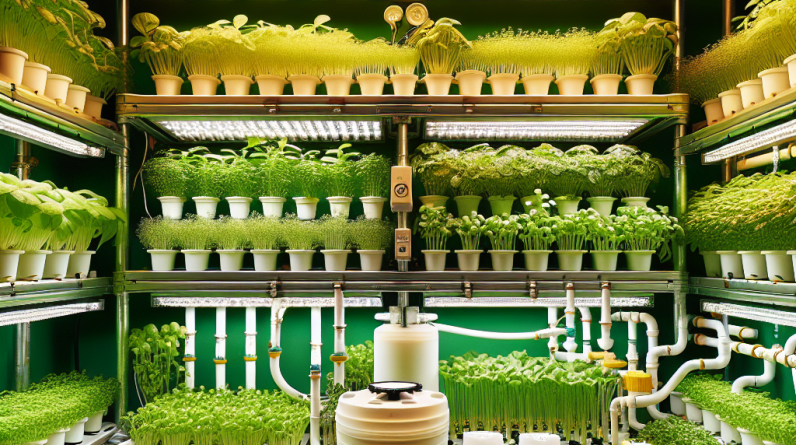
Hey there! I’ve been diving deep into the world of hydroponic gardening, and let me tell you, it’s a game changer—especially for those of us with small living spaces. Whether you live in a tiny apartment or just want to grow some herbs on your balcony, hydroponics can be a super fun and rewarding way to bring greenery into your life. Let’s break this down into five essential areas that will make your hydroponic journey a breeze!
Understanding Hydroponics
What is Hydroponic Gardening?
First, let’s get into the nitty-gritty of what hydroponics actually is. Essentially, it’s a method of growing plants without soil. Crazy, right? Instead, plants are grown in nutrient-rich water. This method can lead to faster growth and potentially higher yields compared to traditional soil gardening.
I remember the first time I tried it—I was skeptical. But seeing those little greens sprout up just made me giddy. Not having soil to deal with means less mess and easier maintenance, which is a huge win for those of us short on space.
Hydroponics can be used to grow all sorts of plants, from leafy greens like lettuce to even fruit-bearing plants like tomatoes and strawberries. The versatility is one of the many reasons I fell in love with it!
Choosing the Right System
Different Types of Hydroponic Systems
Alright, now that you’ve got a grip on what hydroponics is, the next step is picking the right system. There are various types—Nutrient Film Technique (NFT), Ebb and Flow (Flood and Drain), and Deep Water Culture (DWC), just to name a few. Each has its own benefits and challenges.
Personally, I started with Deep Water Culture because it’s easy to set up and manage. You basically suspend your plants in a nutrient solution with oxygen bubbled up to the roots. I was amazed at how quickly my herbs thrived!
Do your homework on each system and think about the space you have available. Some setups can be pretty compact, while others might be more suited for a larger area. You want something that fits your lifestyle and the plants you’re aiming to grow.
Light and Environment
Importance of Light
Light is one of the most crucial factors in hydroponic gardening. If you have access to a sunny windowsill, that’s fantastic! But don’t worry if you’re not blessed with natural sunlight; there are plenty of grow lights available that can provide the spectrum your plants need.
When I set up my first garden, I opted for full-spectrum LED grow lights, and they’ve worked wonders. They not only save energy but also last a long time, which is a big plus for anyone trying to keep costs down.
Make sure to position your lights correctly and maintain a consistent light schedule. Your plants will thrive if they get ample light each day, so don’t skimp on this part!
Nutrients and Water Management
Finding the Right Nutrient Mix
Let’s talk nutrients! Just like us humans need a balanced diet, your plants need the right blend of nutrients to flourish. You’ll want to find a good hydroponic nutrient solution that includes all the essential macro and micronutrients.
I’ll be honest—when I first started, I tried to save a few bucks on the nutrient mix, and it did not go well. My plants were sulking and definitely not vibing. Once I switched to a higher quality nutrient solution, they perked right up and started growing like crazy!
Don’t forget to monitor the pH and EC (electrical conductivity) levels of your water. These numbers will tell you if your plants are getting the nutrients they need or if adjustments are necessary.
Maximizing Space
Vertical Gardening Techniques
Last but not least, let’s chat about maximizing that precious space. In small areas, vertical gardening techniques are your best friend. You can use shelves or wall-mounted systems to stack your plants and make the most out of every square inch.
I have a tiered setup in my little balcony garden, and it’s amazing how much I can grow in such a compact space. Plus, it looks pretty cool, too! Adding some decorative elements can also create a charming display.
Additionally, consider companion planting. Some plants thrive when grown together, so check out combinations that can help each other out while saving you space.
Frequently Asked Questions
1. What are the main benefits of hydroponic gardening?
The main benefits include faster plant growth, higher yields, and the ability to grow in small spaces without soil. You also have greater control over growing conditions!
2. Do I need a lot of equipment to start hydroponic gardening?
Not necessarily! Many beginners start with simple systems. As you get comfortable, you can expand or upgrade your setup. It can be as basic or as intricate as you want.
3. How often should I check the nutrient solution?
It’s a good idea to check it at least once a week. Keeping an eye on the pH and nutrient levels ensures your plants stay happy and healthy.
4. Can I grow hydroponically year-round?
You definitely can! With the right indoor setup, including good lighting and environmental controls, you can grow all year long. It’s a great way to have fresh produce no matter the season.
5. Is hydroponic gardening expensive to start?
It can vary depending on the system you choose. You can find budget-friendly options or invest in more advanced setups. The good news is that many systems pay off in the long run with higher yields.








